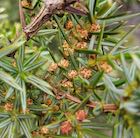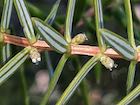Juniperus macrocarpa
Sibth. & Sm. 1816
Common names
Large-fruited juniper, Genévrier à gros fruits [French], enebro marítimo [Spanish],
Büyük kozalaklı ardıç [Turkish].
Taxonomic notes
The synonymy is lengthy and complex; see POWO (accessed 2022.12.22) for a full listing. Many authors continue to treat Juniperus macrocarpa as a variety of J. oxycedrus, which molecular analysis has confirmed as its closest relative; however, in morphology and habitat the two taxa are quite distinct (Adams 2014), thus species rank is appropriate.
Description
Dioecious evergreen shrubs, or trees to 14 m tall, with erect branches. Bark reddish brown, exfoliating in strips. Twigs short, thick, stiff. Leaves needle-like, spreading at nearly right angles from the twig, stiff, 12-20 × 2-2.5 mm, in whorls of 3, acuminate, abaxially keeled, adaxially bearing 2 stomatal bands. Pollen cones 4 × 3 mm when closed, fertile in winter. Seed cones maturing in 2 years, yellowish maturing purplish red, broad ovoid to globose, 15-23 mm long, scale margins often prominent, usually bearing 3 seeds (Adams 2014, Farjon 2010).
Distribution and Ecology
Albania, Algeria, Bosnia-Herzegovina, Bulgaria, Croatia, France (incl. Corsica), Greece (incl. Crete), Italy (incl. Sardinia and Sicily), Libya, Malta, Morocco, Spain (incl. Balearic Islands), Tunisia, Turkey, Ukraine (Crimea), Yugoslavia (POWO, accessed 2022.12.22; Farjon 2010). Coastal on dunes, paleodunes and cliffs of the Mediterranean basin, extending to the Atlantic coast of southwest Spain and the coastal Black Sea; not frost tolerant (Farjon 2010, Diez-Garretas and Asensi 2013). Common associated taxa include Asparagus acutifolius, Chamaerops humilis, Clematis cirrhosa, Clematis flammula, Daphne gnidium, Ephedra fragilis, Juniperus turbinata subsp. turbinata, Myrtus communis, Olea europaea subsp. sylvestris, Osyris alba, Osyris lanceolata, Phillyrea angustifolia, Pinus halepensis, Pistacia lentiscus, Prasium majus, Rhamnus alaternus, Rubia peregrina subsp. longifolia, R. peregrina subsp. peregrina, and Smilax aspera. However, differing associations are reported in some areas, including the Turkish coast of the Black Sea, eastern Libya, and northwest Tuscany (Italy) (Diez-Garretas and Asensi 2013).
Although the species is under some pressure from development, its habitat is extremely widespread and populations are large, which is why the IUCN has assigned this taxon a "Least Concern" conservation status (Farjon 2013, accessed 2022.12.22). However, some contest this assessment, and Diez-Garretas and Asensi (2013) state "Since the mid-twentieth century, the populations have significantly declined. The alteration of the environment due to increased tourism and urban development, the introduction of conifers to sand dune fixation (Pinus sp. pl.) and the presence of alien plants are some of the factors threatening the conservation of these fragile and vulnerable ecosystems."
Remarkable Specimens
No data as of 2023.03.03.
Ethnobotany
There are no known uses (Adams 2014).
Observations
See the collection records on iNaturalist.
Remarks
The epithet macrocarpa refers to the relatively large seed cones.
Citations
Adams, Robert P. 2014. Junipers of the World: The Genus Juniperus. Fourth edition. Trafford Publishing.
Díez-Garretas, B., and A. Asensi. 2014. The coastal plant communities of Juniperus macrocarpa in the Mediterranean region. Plant Biosystems 148(3):429–438. doi:10.1080/11263504.2013.778351.
Sibthorp, J. and J. E. Smith. 1816. Florae Graecae Prodromus. Vol. 2(2):263. Available: Biodiversity Heritage Library, accessed 2022.12.22.
See also
Elwes and Henry 1906-1913 at the Biodiversity Heritage Library. This series of volumes, privately printed, provides some of the most engaging descriptions of conifers ever published. Although they only treat species cultivated in the U.K. and Ireland, and the taxonomy is a bit dated, still these accounts are thorough, treating such topics as species description, range, varieties, exceptionally old or tall specimens, remarkable trees, and cultivation. Despite being over a century old, they are generally accurate, and are illustrated with some remarkable photographs and lithographs.
Threatened Conifers of the World.





